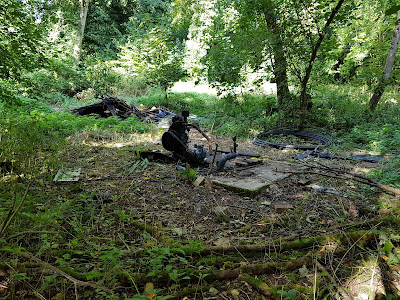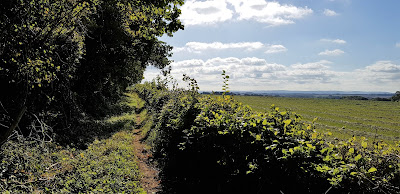I had romantic notions for one spot especially, a lake in central Asia north of Tibet (in what is now north-western China) called Lop Nor. The modern-day reality concerning this 'lake' can be read at https://en.wikipedia.org/wiki/Lop_Nur. But I knew none of that back in 1959 or 1960. I simply imagined a cold, windswept landscape full of yaks and nomadic tribes, and this big mysterious lake. I desperately wanted an atlas that would show me the place in greater detail.
By the time I was eleven, and attending grammar school, I had become aware of the giant Times Atlas of the World. Ah, what would Lop Nor look like on that? As more years passed, I saw the Times Atlas on sale in bookshops, but it was always in a sealed wrapper. And no wonder. It cost a small fortune to buy, and naturally the bookshop couldn't allow grubby fingers to browse one of these tomes unless definitely committing themselves to a purchase. It was far beyond the financial means of any teenager. Indeed, it was extraordinarily expensive for any working adult to consider. But I did finally get a copy of the Times Atlas of the World for my thirty-first birthday in July 1983, and I have it still.
It cost £40 at the time, which is the equivalent of about £135 nowadays. Some present! The superlative maps inside blew me away. They were beautiful - and showed me places around the world in unprecedented detail. Remember that in 1983 the youthful Internet had no public presence at all, and Google Earth and Google Maps were undreamed of. It was possible to go to a London or Edinburgh specialist map shop and buy whatever they might have for the place you were eager to see in detail, but short of doing that, a good atlas was all you could turn to. One of the first things I did, when reverently opening my copy of the Times Atlas back in 1983, was to look up Lop Nor.
Oh, it had shrunk! I hadn't fully realised that it was a salt lake, and had been drying up.
In 2007, when flying back from Hong Kong over north-western China, I saw a lake in the distance that I fancied might well be Lop Nor, as seen in this series of shots from the window next to my seat on the plane:
It was the right kind of landscape, but it probably wasn't Lop Nor. Because in 2019, only twelve years later, it has all but disappeared. Here's the Google Earth view.
Pretty barren now! Oh well.
Much closer to home, there were all kinds of spots in this country that I longed to see for myself. One of these was Rendezvous Lodge, an isolated building up on the Dorset downs south of Blandford Forum. I'd first noticed it on one of my very first proper large-scale maps. In 1964, I'd got the Ordnance Survey's Bournemouth and Solent seventh-series One-inch sheets (179 and 180) for my twelfth birthday. I still have the Bournemouth sheet, though it's much battered and repaired, as you can see. (The markings in blue ink reflect teenage attempts to catalogue my growing map collection)
Rendezvous Lodge was on the western edge of the Bournemouth sheet.
But twelve year olds can't just hop in a car and drive there independently of their parents. And I didn't have access to a car until 1973. By then it was too late. Around 1970 it must have become derelict, and soon after demolished. The only thing left was a clearing where the lodge had stood.
But I didn't forget Rendezvous Lodge. And three months ago, in early October, when pitched not far away, I decided one sunny morning that I would walk to where the lodge had been, and see what signs of it I could still find. I would at least see the lie of the land, and make guesses about what might have been seen from its grounds.
I couldn't find anything on the Internet about its history, but I could at least look at old maps - such as these old large-scale Ordnance Survey maps, courtesy of the National Library of Scotland. This was the lodge in 1887:
As you can see, it was inside Rendezvous Plantation, but then called Coll Wood Lodge. Little Coll Wood and Great Coll Wood are woods not far away to the south west, and I should think that Rendezvous Plantation was a more recent planting. Quite possibly the lodge had a wide view over the tops of young saplings.
By 1902 the lodge had been renamed:
Its last appearance was in 1969, on this map of my own:
There's still a building marked, but it isn't named. The stable block has gone, and the garden has shrunk. After this, the lodge vanished. Only a clearing remained, as in this phone screenshot of the 2017-edition map:
You might have said to me, on that sunny morning last October, why bother? It's a longish walk to see little or nothing. But I wanted the long walk. It was a beautiful day. And even if there were only rubble to see, at least the pilgrimage would have been made, and a childhood dream fulfilled.
It was only a twenty-minute drive, north-west to Bere Regis, east on the A31, and then a short turn-off to Mapperton, where I parked Fiona. I took care to place her so that passing tractors and their trailers wouldn't scrape her. I was facing a long gravel track. I was going to head north-west from Mapperton, up that track, and just keep going until I reached the lodge. Then I'd return southwards along the western edge of Great Coll Wood to Winterbourne Zelston, and finally cut eastwards to Mapperton again. These maps should make the route clear:
And here's the track at the start of my walk. You can see what a fine morning it was; just a hint of autumn chill in the air - hence the cardigan. But that would probably end up around my waist as the exercise warmed me up.
Naturally I was wearing my Alt-Berg boots, and carrying a stick.
I also had a bottle of water with me, and there was fruit to eat when I eventually got back to Fiona.
As country tracks go, this wasn't bad. But it was strictly for farm vehicles, and the local farmer had put up a warning notice for those who slavishly followed the instructions of their SatNavs.
I had a two-mile uphill trek to the lodge, and the gently-rolling countryside wasn't all that interesting. The only noteworthy man-made things I saw were these rather odd, skinny electricity pylons. I can't recall seeing that design before.
Gradually I got nearer to Rendezvous Plantation. That's it, centre-shot, up ahead.
I now met two ladies coming the other way. We said hello. It crossed my mind that this was in fact rather lonely countryside, and walking without a companion might not be the wisest thing for a single woman to do. Who knows what mad axemen (and the like) were lurking in these woods, waiting for victims? I thrust the thought away. On a sunny day like this? No, I was all right. And I had my stick.
The track now levelled off and began to run downhill. I took a shot to celebrate my arrival.
Then the Plantation appeared on my left. Hmm. Looked pretty dense. Coppiced at one time, but now left to grow as it would.
The track got a little steeper, then levelled off at the bottom. I was looking for a side-track that would have once run past the main lodge building. There was such a track, well maintained too. Ah, there was a notice to discourage the curious...
NO ENTRY
Biosecurity Precautions
STOP
Please obtain permission
to enter pig unit
Contact 07818 551291
Well, this invited a mischievous phone conversation, didn't it?
'Oh hello, I'm a pig. Just passing by, and I was wondering if I could pop in, you know. I won't stay long. Only wanted to swap a grunt or two, then go. Would that be all right?'
I decided to resist the temptation to see what lay at the other end of the side-track. It would be embarrassing if stern men in protective suits, goggles and breathing apparatus saw me.
Well, was there anything at all in the immediate vicinity? What signs were left of the old lodge? Where was that pile of rubble? I cast around but, disappointingly, there was precious little to see. I suppose that in the course of fifty-odd years since its demolition, the lodge site had become overgrown and everything had gone back to nature.
Not quite. Roughly where the lodge might have been was a concrete or cement plinth, and on that was a very old and oily diesel engine.
Was it a pump or a generator? It certainly looked very old, and might well have been in situ when the lodge was still a going concern, and the plinth was once the floor (or part of the floor) of an outbuilding or shed. If so, it was the last major relic of Rendezvous Lodge. No walls, no wisteria, just this mucky device. How sad.
But what's this? A single old brick! The lodge itself! My pilgrimage was rewarded.
There was nothing more to see, and I didn't want to be discovered trespassing. So, thoughtfully, I went back to the main track and back up the slope, looking for a public footpath that would take me across to Great Coll Wood. This ran along the south edge of Rendezvous Plantation, then out into the open. Ah, a fine view of rolling countryside and biosecure pig sheds...
Where were the pigs? On holiday?
It was getting warm. Off came the cardigan, and out came the water bottle. It seems odd now, in cold January, to see myself so lightly clad!
Not quite the last strong sunshine of 2018, but nearly.
I reached the north-west corner of Great Coll Wood, and I was pleased. It would be (for me) a longish walk by the time I got back to Fiona, but this was the point furthest from my car and now I would be on the return stretch. Just as well. I'd hurt the ligament in my left knee nine days earlier, and it was giving me trouble if I over-exercised my left leg. The discomfort was unwelcome but manageable. But I think it shows in my face (in the next shot) that I expected to be limping anon.
The view from here was pretty decent, if you liked quiet, empty fields.
At first the path kept out in the open, after a while it switched to a route just inside the wood, without a sunny view. I felt enclosed by the wood, and had a mile of this ahead. It definitely felt creepy. Once again, I questioned my wisdom in walking alone in such isolated places. What would I really do, if some man approached, especially if he looked in any way odd or shifty? Old chaps with serious backpacking gear, pukka ornithologists with binoculars, and official-looking farm or forestry workers in credible overalls or some sort of uniform were one thing; sly characters with ferret eyes quite another. My stick didn't feel all that reassuring. Then the bright sunlit world beyond the wood came into view. Great relief!
I was past that gate and out of that wood in an instant.
Phew.
Now it was gently downhill to Winterbourne Zelston. Next post.








































